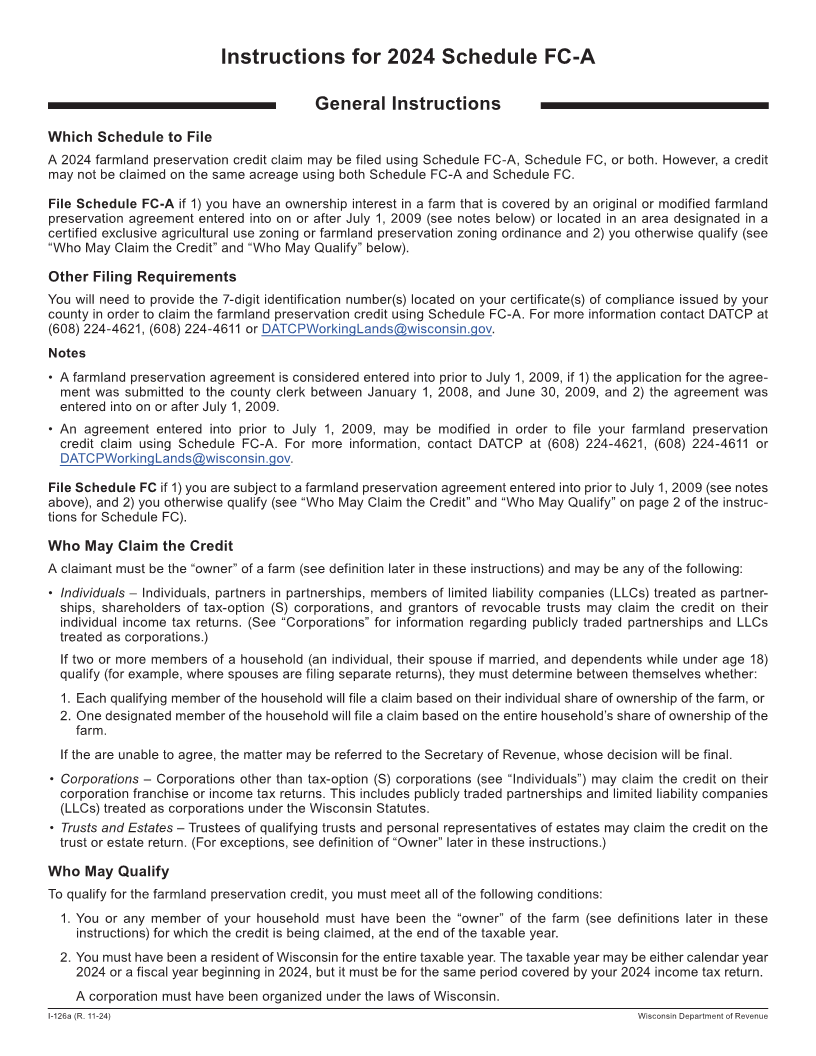
Enlarge image
Instructions for 2024 Schedule FC‑A
General Instructions
Which Schedule to File
A 2024 farmland preservation credit claim may be filed using Schedule FC‑A, Schedule FC, or both. However, a credit
may not be claimed on the same acreage using both Schedule FC‑A and Schedule FC.
File Schedule FC‑A if 1) you have an ownership interest in a farm that is covered by an original or modified farmland
preservation agreement entered into on or after July 1, 2009 (see notes below) or located in an area designated in a
certified exclusive agricultural use zoning or farmland preservation zoning ordinance and 2) you otherwise qualify (see
“Who May Claim the Credit” and “Who May Qualify” below).
Other Filing Requirements
You will need to provide the 7‑digit identification number(s) located on your certificate(s) of compliance issued by your
county in order to claim the farmland preservation credit using Schedule FC‑A. For more information contact DATCP at
(608) 224‑4621, (608) 224‑4611 or DATCPWorkingLands@wisconsin.gov.
Notes
• A farmland preservation agreement is considered entered into prior to July 1, 2009, if 1) the application for the agree‑
ment was submitted to the county clerk between January 1, 2008, and June 30, 2009, and 2) the agreement was
entered into on or after July 1, 2009.
• An agreement entered into prior to July 1, 2009, may be modified in order to file your farmland preservation
credit claim using Schedule FC‑A. For more information, contact DATCP at (608) 224‑4621, (608) 224‑4611 or
DATCPWorkingLands@wisconsin.gov.
File Schedule FC if 1) you are subject to a farmland preservation agreement entered into prior to July 1, 2009 (see notes
above), and 2) you otherwise qualify (see “Who May Claim the Credit” and “Who May Qualify” on page 2 of the instruc‑
tions for Schedule FC).
Who May Claim the Credit
A claimant must be the “owner” of a farm (see definition later in these instructions) and may be any of the following:
• Individuals – Individuals, partners in partnerships, members of limited liability companies (LLCs) treated as partner‑
ships, shareholders of tax‑option (S) corporations, and grantors of revocable trusts may claim the credit on their
individual income tax returns. (See “Corporations” for information regarding publicly traded partnerships and LLCs
treated as corporations.)
If two or more members of a household (an individual, their spouse if married, and dependents while under age 18)
qualify (for example, where spouses are filing separate returns), they must determine between themselves whether:
1. Each qualifying member of the household will file a claim based on their individual share of ownership of the farm, or
2. One designated member of the household will file a claim based on the entire household’s share of ownership of the
farm.
If the are unable to agree, the matter may be referred to the Secretary of Revenue, whose decision will be final.
• Corporations – Corporations other than tax‑option (S) corporations (see “Individuals”) may claim the credit on their
corporation franchise or income tax returns. This includes publicly traded partnerships and limited liability companies
(LLCs) treated as corporations under the Wisconsin Statutes.
• Trusts and Estates – Trustees of qualifying trusts and personal representatives of estates may claim the credit on the
trust or estate return. (For exceptions, see definition of “Owner” later in these instructions.)
Who May Qualify
To qualify for the farmland preservation credit, you must meet all of the following conditions:
1. You or any member of your household must have been the “owner” of the farm (see definitions later in these
instructions) for which the credit is being claimed, at the end of the taxable year.
2. You must have been a resident of Wisconsin for the entire taxable year. The taxable year may be either calendar year
2024 or a fiscal year beginning in 2024, but it must be for the same period covered by your 2024 income tax return.
A corporation must have been organized under the laws of Wisconsin.
I-126a (R. 11-24) Wisconsin Department of Revenue



